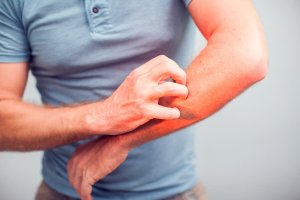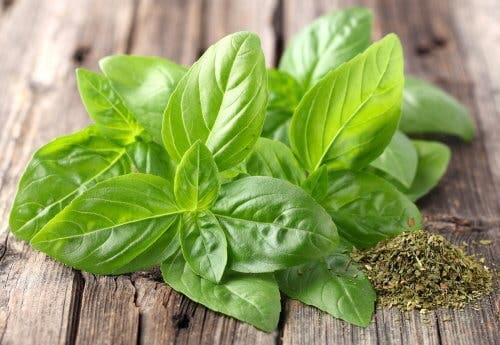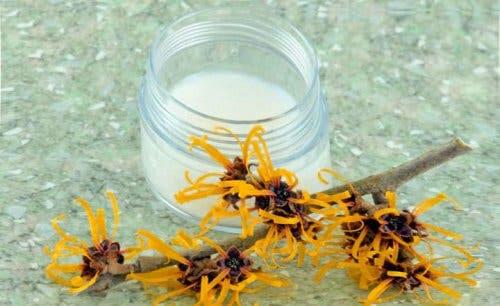5 Natural Remedies to Relieve Itching

If your skin is itching, it’s important for you to avoid scratching it with your nails. Although this action can provide momentary relief, sometimes it prolongs the duration of the symptom or damages the skin. What to do to relieve itching?
Firstly, you should evaluate the possible cause of the itching, preferably by consulting your doctor. The medical professional has the power to determine whether it’s an allergy or the underlying symptom of other diseases. Subsequently, they’ll prescribe the most appropriate treatment.
Likewise, you can try some natural remedies whose properties regulate skin pH and reduce discomfort. Below, we share five good natural remedies to relieve itching. Don’t hesitate to try them out whenever you suffer from this bothersome symptom!
Natural remedies to relieve itching
Itching is an irritating and annoying sensation that can be accompanied by dryness, redness, and inflammation, among other symptoms.
The most common causes of itching are bug bites and allergies. However, it can also occur due to food intolerances, fungal infections, kidney disease, contact with chemical substances, and other factors.
Currently, topical products can help speed up relief, acting almost immediately. However, you can also use some natural solutions. Do you want to know which ones they are?
Discover: What is Eczema? Learn about its Causes, Symptoms, Diagnosis and Treatment
1. Colloidal oatmeal

Colloidal oatmeal isn’t the typical oatmeal people have for breakfast. This product consists of oatmeal that’s been ground into a very fine powder for use in natural remedies, soaps, and body creams, among others. According to a 2012 study, colloidal oatmeal fights itching and reduces dry skin.
How to use it
- Firstly, we should note that you can find it in pharmacies or certain cosmetic stores.
- Once you buy the product, add it to your bathtub and soak for 20 minutes.
- This natural remedy should be enough to calm the itching. However, if the symptom persists, you can repeat twice a day.
2. Aloe vera
Famous for its dermatological applications, aloe vera has calming compounds that significantly decrease itching. Likewise, it deeply hydrates tissues and controls symptoms such as redness, peeling, and burning.
How to use it
- Firstly, extract a generous amount of aloe vera gel
- Then, rub the product over the affected areas
- Repeat twice a day until the symptom subsides
3. Basil

Although this plant is popular for its culinary applications, it’s important to know that it has interesting uses in natural medicine. Thanks to the fact that it contains a compound called eugenol, it reduces irritation and helps to relieve itching.
How to use it
- Firstly, take a couple of tablespoons of dried basil leaves and put them into a pot of water
- Boil the drink for five minutes over low heat
- Then, let it sit until it’s warm or cold
- Finally, rub the preparation over the itchy areas with a cotton ball
- Repeat its use up to three times a day if you consider it necessary
You should also read: The Differences between Atopic and Seborrheic Dermatitis
4. Apple cider vinegar
For hundreds of years, apple cider vinegar has been an ally in accelerating the relief of many skin problems. Thanks to the fact that it contains acetic acid and antioxidant compounds, it regulates pH levels and minimizes discomfort, such as stinging and burning.
In fact, it’s one of the best solutions when itching is caused by stings or burns. This is because it reduces inflammation and produces a quick sense of relief. In addition, it’s a natural disinfectant to reduce the risk of possible infections when you damage your skin due to scratching.
How to use it
- For starters, mix equal parts organic apple cider vinegar with water
- Then, dip a cotton cloth into the preparation and apply it to the affected area
- Optionally, you can pour the vinegar into your tub water and take a 20-minute bath
- Repeat the treatment if you consider it necessary
5. Witch hazel

In fact, witch hazel contains substances known as tannins, which act as astringents when applied topically. Because of this, witch hazel lotion or cream can relieve itching, minimizing irritation and redness.
How to use it
- Buy witch hazel at the pharmacy or make it at home by boiling the dried plant in water
- Subsequently, rub the product over the affected areas and let it act without rinsing
- If your symptom persists, repeat twice a day
Do you scratch your skin when you feel itchy? Avoid doing so from now on! Instead, try some of the natural remedies to relieve itching we mentioned in this article.
All cited sources were thoroughly reviewed by our team to ensure their quality, reliability, currency, and validity. The bibliography of this article was considered reliable and of academic or scientific accuracy.
- Akhavan Amjadi, M., Mojab, F., & Kamranpour, S. B. (2012). The effect of peppermint oil on symptomatic treatment of pruritus in pregnant women. Iranian journal of pharmaceutical research : IJPR, 11(4), 1073–1077. https://www.ncbi.nlm.nih.gov/pmc/articles/PMC3813175
- Allais, B., & Friedman, A. (2020). ARTICLE: Colloidal Oatmeal Part I: History, Basic Science, Mechanism of Action, and Clinical Efficacy in the Treatment of Atopic Dermatitis. Journal of drugs in dermatology : JDD, 19(10), s4–s7. https://pubmed.ncbi.nlm.nih.gov/33026768/
- Batiha, G. E.-S., Tene, S. T., Teibo, J. O., Shaheen, H. M., Oluwatoba, O. S., Teibo, T. K. A., Al-kuraishy, H. M., Al-Garbee, A. I., Alexiou, A., & Papadakis, M. (2023). The phytochemical profiling, pharmacological activities, and safety of malva sylvestris: a review. Naunyn-Schmiedeberg’s Archives of Pharmacology, 396(3), 421–440. https://link.springer.com/article/10.1007/s00210-022-02329-w
- Bathing and eczema. (2017). National Eczema Association. https://nationaleczema.org/eczema/treatment/bathing/
- Cerio, R., Dohil, M., Jeanine, D., Magina, S., Mahé, E., & Stratigos, A. J. (2010). Mechanism of action and clinical benefits of colloidal oatmeal for dermatologic practice. Journal of drugs in dermatology : JDD, 9(9), 1116–1120. https://pubmed.ncbi.nlm.nih.gov/20865844/
- Charousaei, F., Dabirian, A., & Mojab, F. (2011). Using chamomile solution or a 1% topical hydrocortisone ointment in the management of peristomal skin lesions in colostomy patients: results of a controlled clinical study. Ostomy/wound management, 57(5), 28–36. https://pubmed.ncbi.nlm.nih.gov/21617262/
- Chukwuma, I. F., Uchendu, N. O., Asomadu, R. O., Ezeorba, W. F. C., & Ezeorba, T. P. C. (2023). African and Holy Basil – a review of ethnobotany, phytochemistry, and toxicity of their essential oil: Current trends and prospects for antimicrobial/anti-parasitic pharmacology. Arabian Journal of Chemistry, 16(7), 104870. https://www.sciencedirect.com/science/article/pii/S1878535223003325
- Elhage, K. G., St. Claire, K., & Daveluy, S. (2022). Acetic acid and the skin: a review of vinegar in dermatology. International Journal of Dermatology, 61(7), 804–811. https://onlinelibrary.wiley.com/doi/abs/10.1111/ijd.15804
- Feily, A., & Namazi, M. R. (2009). Aloe vera in dermatology: a brief review. Giornale italiano di dermatologia e venereologia : organo ufficiale, Societa italiana di dermatologia e sifilografia, 144(1), 85–91. https://pubmed.ncbi.nlm.nih.gov/19218914/
- How to relieve itchy skin. (s/f). American Academy of Dermatology (AAD). https://www.aad.org/public/everyday-care/itchy-skin/itch-relief/relieve-itchy-skin
- Ilnytska, O., Kaur, S., Chon, S., Reynertson, K. A., Nebus, J., Garay, M., Mahmood, K., & Southall, M. D. (2016). Colloidal Oatmeal (Avena Sativa) Improves Skin Barrier Through Multi-Therapy Activity. Journal of drugs in dermatology : JDD, 15(6), 684–690. https://pubmed.ncbi.nlm.nih.gov/27272074/
- Jones, K. (2018). Get the facts: Using apple cider vinegar to treat eczema. National Eczema Association. https://nationaleczema.org/blog/get-the-facts-acv/
- Kuchewar, V., Umate, N., & Parwe, S. (2022). A narrative review on use of virgin coconut oil in dermatology. Journal of Indian System of Medicine, 10(2), 86. https://journals.lww.com/jism/fulltext/2022/10020/a_narrative_review_on_use_of_virgin_coconut_oil_in.3.aspx
- Laneri, S., Di Lorenzo, R. M., Bernardi, A., Sacchi, A., & Dini, I. (2020). Aloe barbadensis: A Plant of Nutricosmetic Interest. Natural Product Communications, 15(7), 1934578X2093274. https://doi.org/10.1177/1934578×20932744
- Liu, B., & Jordt, S. E. (2018). Cooling the Itch via TRPM8. The Journal of investigative dermatology, 138(6), 1254–1256. https://www.ncbi.nlm.nih.gov/pmc/articles/PMC6301073
- Maksoud, S., Abdel-Massih, R. M., Rajha, H. N., Louka, N., Chemat, F., Barba, F. J., & Debs, E. (2021). Citrus aurantium L. Active Constituents, Biological Effects and Extraction Methods. An Updated Review. Molecules (Basel, Switzerland), 26(19), 5832. https://www.ncbi.nlm.nih.gov/pmc/articles/PMC8510401/
- Moosavi M. (2017). Bentonite Clay as a Natural Remedy: A Brief Review. Iranian journal of public health, 46(9), 1176–1183. https://www.ncbi.nlm.nih.gov/pmc/articles/PMC5632318/
- Perrelli, A., Goitre, L., Salzano, A. M., Moglia, A., Scaloni, A., & Retta, S. F. (2018). Biological Activities, Health Benefits, and Therapeutic Properties of Avenanthramides: From Skin Protection to Prevention and Treatment of Cerebrovascular Diseases. Oxidative medicine and cellular longevity, 2018, 6015351. https://www.ncbi.nlm.nih.gov/pmc/articles/PMC6126071/
- Piazza, S., Martinelli, G., Vrhovsek, U., Masuero, D., Fumagalli, M., Magnavacca, A., Pozzoli, C., Canilli, L., Terno, M., Angarano, M., Dell’Agli, M., & Sangiovanni, E. (2022). Anti-Inflammatory and Anti-Acne Effects of Hamamelis virginiana Bark in Human Keratinocytes. Antioxidants (Basel, Switzerland), 11(6), 1119. https://www.ncbi.nlm.nih.gov/pmc/articles/PMC9220085/
- Rasul, A., & Akhtar, N. (2011). Formulation and in vivo evaluation for anti-aging effects of an emulsion containing basil extract using non- invasive biophysical techniques. Daru : journal of Faculty of Pharmacy, Tehran University of Medical Sciences, 19(5), 344–350. https://pubmed.ncbi.nlm.nih.gov/22615680/
- Sanders, K. M., & Akiyama, T. (2018). The vicious cycle of itch and anxiety. Neuroscience and biobehavioral reviews, 87, 17–26. https://www.ncbi.nlm.nih.gov/pmc/articles/PMC5845794/
- Srivastava, J. K., Shankar, E., & Gupta, S. (2010). Chamomile: A herbal medicine of the past with bright future. Molecular medicine reports, 3(6), 895–901. https://www.ncbi.nlm.nih.gov/pmc/articles/PMC2995283/
- Saleem, Aisha & Naureen, Irum & Naeem, Muhammad & Murad, Hafiza & Maqsood, Samra & Tasleem, Gulnaz. (2022). Aloe Vera Gel Effect on Skin and Pharmacological Properties. Scholars International Journal of Anatomy and Physiology. 5. 1-8. 10.36348/sijap.2022.v05i01.001.
- Varma, S. R., Sivaprakasam, T. O., Arumugam, I., Dilip, N., Raghuraman, M., Pavan, K. B., Rafiq, M., & Paramesh, R. (2018). In vitro anti-inflammatory and skin protective properties of Virgin coconut oil. Journal of traditional and complementary medicine, 9(1), 5–14. https://www.ncbi.nlm.nih.gov/pmc/articles/PMC6335493/
- Williams, L. B., & Haydel, S. E. (2010). Evaluation of the medicinal use of clay minerals as antibacterial agents. International geology review, 52(7/8), 745–770. https://www.ncbi.nlm.nih.gov/pmc/articles/PMC2904249/
This text is provided for informational purposes only and does not replace consultation with a professional. If in doubt, consult your specialist.








